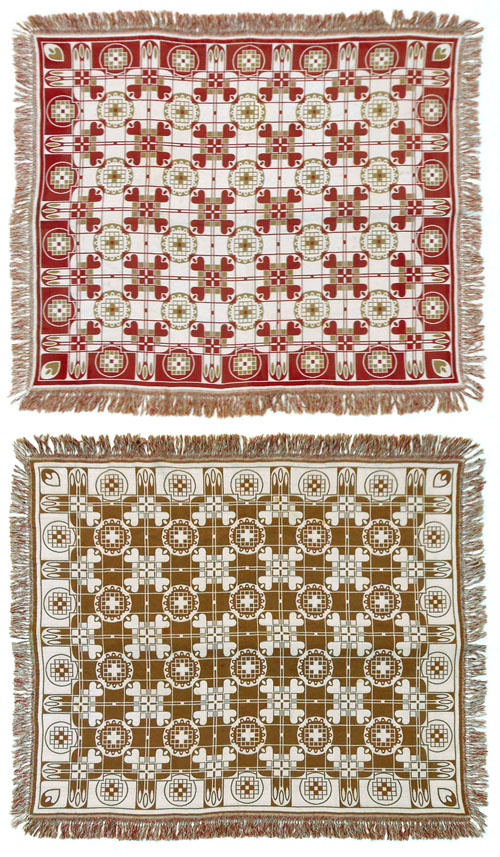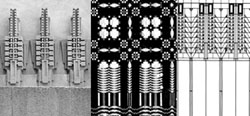
VIENNA SECESSION-STYLE COVERLET
Double-weave cotton, 53 inches X 64 inches (exclusive of fringe)

The provenance and design of this double weave cover lead me to believe it was woven in Germany or Austria at the turn of the twentieth century.
It was found in a Minneapolis house with associations to John Scott Bradstreet. While I don’t think Bradstreet had anything to do with the design of this piece, I do think its use in a “modern” house in an area with a strong Germanic heritage is significant. Tastemakers like Gustav Stickley recommended the use of early nineteenth-century coverlets for portieres and pillow covers. However, the textiles he was writing about were the products of professional itinerant weavers who were often German immigrants, who lugged their Jacquard looms from house to house.
The introduction of the Jacquard loom attachment to the United States about the year 1825 revolutionized weaving in this country as it had in Europe twenty years earlier. The Jacquard mechanism, with its series of punched cards, allowed a single weaver to produce almost any design with relative ease.

Center: American coverlet ca. 1850; left: Hollyhock House, Frank Lloyd Wright, 1927; right: “tree of life,” Frank Lloyd Wright, 1907

Some early nineteenth-century American coverlets do have designs that, in retrospect, seem to be precursors of modernistic styles like the Prairie School, their geometric motifs are often based on things like pine trees and one need only to reference the “Pennsylvania Dutch” traditions to see that hearts have always been beloved by German American artisans. But the grid-work crosses and pointed ovals that form the borders on this coverlet suggest the designs of Vienna Secession (founded in 1897) or German Work Federation (founded in 1907) designers like Josef Hoffmann and Peter Behrens. Even the weave has a rigid grid that is not typical of American double woven coverlets. The complicated double weave technique enables the weaver to produce simultaneously two layers of cloth, which intersect at intervals. Double weave coverlets are reversible and typically bold in contrast. The traditional blue, brick red, and off white colors of American “summer-winter” coverlets are usually exact inversions from one side to the other thus giving a darker winter side and a lighter summer side. No clear red shows on the khaki and pure white side of this weaving, which I hesitate to call a coverlet because the diminutive dimensions might be those of a table cover and not a bed cover.
